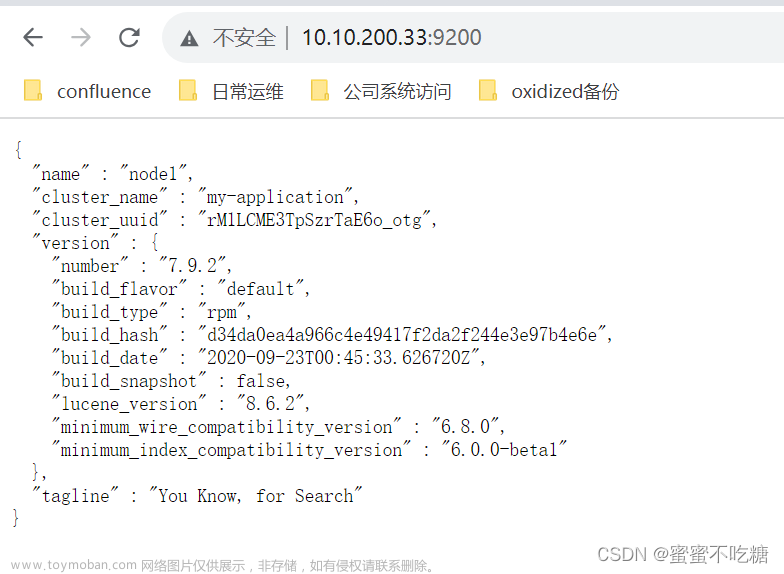目录
一、Filebeat 收集 Nginx 日志实践
1.1 为什么收集 Nginx 日志
1.2 Nginx 日志收集架构图
1.3 Nginx 日志收集实践
1.3.1 安装 Nginx
1.3.2 配置 filebeat
1.3.3 kibana 展示
1.4 Nginx json 日志收集实践
1.4.1 收集问题
1.4.2 解决方案
1.4.3 配置 json
1.4.4 配置 Filebeat
1.4.5 Kibana 展示
1.5 Nginx 多个日志收集实践
1.5.1 配置 Filebeat
1.5.2 kibana 展示
1.6 Nginx 多虚拟主机收集实践
1.6.1 nginx 配置多站点
1.6.2 配置 Filebeat
1.6.3 kibana 展示
二、Filebeat 收集 Tomcat 日志
2.1 Tomcat 日志收集思路
2.2 Tomcat 日志收集架构图
2.3 Tomcat 访问日志收集实践
2.3.1 安装 Tomcat
2.3.2 修改日志为 json 格式
2.3.3 配置 Filebeat
2.3.4 配置 kibana
2.4 Tomcat 错误日志收集实践
2.4.1 错误日志特点
2.4.2 错误日志收集思路
2.4.3 错误日志收集实践
2.4.4 kibana 展示
2.5 收集多台 Tomcat 节点日志
三、ES 错误日志收集实践
一、Filebeat 收集 Nginx 日志实践
1.1 为什么收集 Nginx 日志
我们需要获取用户的信息,比如:来源的 IP 是哪个地域,网站的 PV、UV、状态码、访问时间等等,所以需要收集 Nginx 日志。
1.2 Nginx 日志收集架构图
nginx+filebeat --> elasticsearch --> kibana

1.3 Nginx 日志收集实践
1.3.1 安装 Nginx
[root@se-node3 ~]# yum -y install nginx
[root@se-node3 ~]# vim /etc/nginx/conf.d/elk.conf
server {
listen 80;
server_name elk.com;
location / {
root /opt;
index index.html;
}
}
[root@se-node3 ~]# echo elk123 >> /opt/index.html
[root@se-node3 ~]# systemctl enable --now nginx.service
1.3.2 配置 filebeat
配置 Filebeat,收集本机 Nginx 的日志:
[root@se-node3 ~]# vim /etc/filebeat/filebeat.yml
filebeat.inputs:
- type: log # 收集日志的类型
enabled: true # 启用日志收集
paths:
- /var/log/nginx/access.log # 日志所在路径
#include_lines: ['^WARN', '^ERR', 'sshd', '^CROND', '^systemd']
output.elasticsearch: # 输出日志至 es
hosts: ["192.168.170.132:9200", "192.168.170.133:9200", "192.168.170.134:9200"] # es 集群 ip 和端口
enabled: true
index: "nginx-access-%{[agent.version]}-%{+yyyy.MM.dd}" # 自定义索引名称
setup.ilm.enabled: false # 索引生命周期 ilm 功能默认开启,开启情况下索引名称只能为 filebeat-*
setup.template.name: "nginx" # 定义模板名称
setup.template.pattern: "nginx-*" # 定义模板的匹配索引名称
[root@se-node3 ~]# systemctl restart filebeat.service
1.3.3 kibana 展示
使用 kibana 添加索引(nginx-access*),然后展示数据:

1.4 Nginx json 日志收集实践
1.4.1 收集问题
我们实现了 Nginx 日志的收集,但是所有的数据都在 message 字段中,无法满足分析的需求,比如:
-
需要统计状态码的情况
-
统计所有请求总产生的流量大小
-
统计来源使用的客户端等等
这些是没有办法实现的。
1.4.2 解决方案
需要将日志中的每一个选项都拆分出来,拆分成 key-value 的形式,那么就需要借助 json 的格式。
-
基本写法: sky 男 20
-
json 写法: 姓名: sky 性别: 男 年龄: 20
当需要筛选年龄时,通过JSON 的方式就能很好的提取出对应指标的值。这样也便于后续的分析。
1.4.3 配置 json
将 nginx 日志格式转换成 json 格式:
# 配置 log_format 即可
[root@se-node3 ~]# vim /etc/nginx/nginx.conf
······
http {
log_format main '$remote_addr - $remote_user [$time_local] "$request" '
'$status $body_bytes_sent "$http_referer" '
'"$http_user_agent" "$http_x_forwarded_for"';
log_format json '{ "time_local": "$time_local", '
'"remote_addr": "$remote_addr", '
'"referer": "$http_referer", '
'"request": "$request", '
'"status": "$status", '
'"bytes": "$body_bytes_sent", '
'"browser_agent": "$http_user_agent", '
'"x_forwarded": "shttp_x_forwarded_for", '
'"up_addr": "Supstream addr", '
'"up_host": "$upstream_http_host", '
'"upstream_time": "$upstream_response_time", '
'"request_time": "$request_time"'
'}';
access_log /var/log/nginx/access.log json;
······1.4.4 配置 Filebeat
nginx 修改日志为 JSON 格式后,需要修改 filebeat 配置文件:
[root@se-node3 ~]# vim /etc/filebeat/filebeat.yml
filebeat.inputs:
- type: log # 收集日志的类型
enabled: true # 启用日志收集
paths:
- /var/log/nginx/access.log # 日志所在路径
#include_lines: ['^WARN', '^ERR', 'sshd', '^CROND', '^systemd']
json.keys_under_root: true # 默认为 false 将 json 解析的格式存储至 messages 字段,true 则不存储至 messages 字段
json.overwrite_keys: true # 覆盖默认的 messages 字段,使用自定义 json 格式的 key
output.elasticsearch: # 输出日志至 es
hosts: ["192.168.170.132:9200", "192.168.170.133:9200", "192.168.170.134:9200"] # es 集群 ip 和端口
enabled: true
index: "nginx-access-%{[agent.version]}-%{+yyyy.MM.dd}" # 自定义索引名称
setup.ilm.enabled: false # 索引生命周期 ilm 功能默认开启,开启情况下索引名称只能为 filebeat-*
setup.template.name: "nginx" # 定义模板名称
setup.template.pattern: "nginx-*" # 定义模板的匹配索引名称
# 重启 nginx、Filebeat 并清空日志,重新生产 json 格式的日志
[root@se-node3 ~]# systemctl reload nginx.service
[root@se-node3 ~]# systemctl restart filebeat.service
[root@se-node3 ~]# > /var/log/nginx/access.log1.4.5 Kibana 展示
每次修改完 Filebeat 的配置文件后都需要删除 es、Kibana 的索引,并重新创建 kibana 索引模式才能生效:

1.5 Nginx 多个日志收集实践
nginx 存在访问日志和错误日志,那么如何使用 filebeat 同时收集 nginx 的访问日志、错误日志呢;我们希望的状态如下:
-
nginx 访问日志--存储--> nginx-access-7.8.1-2023.03 索引
-
nginx 错误日志--存储--> nginx-error-7.8.1-2023.03 索引

1.5.1 配置 Filebeat
配置 Filebeat 收集多个日志,需要通过 tags 标签进行区分:
[root@se-node3 ~]# vim /etc/filebeat/filebeat.yml
filebeat.inputs:
- type: log # 收集日志的类型
enabled: true # 启用日志收集
paths:
- /var/log/nginx/access.log # 日志所在路径
#include_lines: ['^WARN', '^ERR', 'sshd', '^CROND', '^systemd']
json.keys_under_root: true
json.overwrite_keys: true
tags: ["nginx-access"]
- type: log # 收集日志的类型
enabled: true # 启用日志收集
paths:
- /var/log/nginx/error.log # 日志所在路径
tags: ["nginx-error"]
output.elasticsearch: # 输出日志至 es
hosts: ["192.168.170.132:9200", "192.168.170.133:9200", "192.168.170.134:9200"] # es 集群 ip 和端口
enabled: true
indices:
- index: "nginx-access-%{[agent.version]}-%{+yyyy.MM.dd}" # 自定义索引名称
when.contains:
tags: "nginx-access" # tags 为 nginx-access 的日志存储至 nginx-access-* 索引
- index: "nginx-error-%{[agent.version]}-%{+yyyy.MM.dd}" # 自定义索引名称
when.contains:
tags: "nginx-error" # tags 为 nginx-error 的日志存储至 nginx-error-* 索引
setup.ilm.enabled: false # 索引生命周期 ilm 功能默认开启,开启情况下索引名称只能为 filebeat-*
setup.template.name: "nginx" # 定义模板名称
setup.template.pattern: "nginx-*" # 定义模板的匹配索引名称
[root@se-node3 ~]# systemctl restart filebeat.service
1.5.2 kibana 展示
使用 kibana 添 nginx 错误日志索引,然后展示数:

1.6 Nginx 多虚拟主机收集实践
Nginx 如果有多个站点,filebeat 该如何收集多个域名的访问日志。

1.6.1 nginx 配置多站点
[root@se-node3 ~]# vim /etc/nginx/conf.d/elk.conf
server {
listen 80;
server_name elk.com;
access_log /var/log/nginx/elk.log json;
location / {
root /opt;
index index.html;
}
}
[root@se-node3 ~]# cp /etc/nginx/conf.d/elk.conf /etc/nginx/conf.d/kk.conf
[root@se-node3 ~]# vim /etc/nginx/conf.d/kk.conf
server {
listen 86;
server_name kk.com;
access_log /var/log/nginx/kk.log json;
location / {
root /opt;
index index.html;
}
}
[root@se-node3 ~]# systemctl reload nginx.service
1.6.2 配置 Filebeat
[root@se-node3 ~]# vim /etc/filebeat/filebeat.yml
filebeat.inputs:
- type: log # 收集日志的类型
enabled: true # 启用日志收集
paths:
- /var/log/nginx/access.log # 日志所在路径
#include_lines: ['^WARN', '^ERR', 'sshd', '^CROND', '^systemd']
json.keys_under_root: true
json.overwrite_keys: true
tags: ["nginx-access"]
- type: log # 收集日志的类型
enabled: true # 启用日志收集
paths:
- /var/log/nginx/elk.log # 日志所在路径
json.keys_under_root: true
json.overwrite_keys: true
tags: ["nginx-elk-access"]
- type: log # 收集日志的类型
enabled: true # 启用日志收集
paths:
- /var/log/nginx/kk.log # 日志所在路径
json.keys_under_root: true
json.overwrite_keys: true
tags: ["nginx-kk-access"]
- type: log # 收集日志的类型
enabled: true # 启用日志收集
paths:
- /var/log/nginx/error.log # 日志所在路径
tags: ["nginx-error"]
output.elasticsearch: # 输出日志至 es
hosts: ["192.168.170.132:9200", "192.168.170.133:9200", "192.168.170.134:9200"] # es 集群 ip 和端口
enabled: true
indices:
- index: "nginx-access-%{[agent.version]}-%{+yyyy.MM.dd}" # 自定义索引名称
when.contains:
tags: "nginx-access"
- index: "nginx-elk-access-%{[agent.version]}-%{+yyyy.MM.dd}" # 自定义索引名称
when.contains:
tags: "nginx-elk-access"
- index: "nginx-kk-access-%{[agent.version]}-%{+yyyy.MM.dd}" # 自定义索引名称
when.contains:
tags: "nginx-kk-access"
- index: "nginx-error-%{[agent.version]}-%{+yyyy.MM.dd}" # 自定义索引名称
when.contains:
tags: "nginx-error"
setup.ilm.enabled: false # 索引生命周期 ilm 功能默认开启,开启情况下索引名称只能为 filebeat-*
setup.template.name: "nginx" # 定义模板名称
setup.template.pattern: "nginx-*" # 定义模板的匹配索引名称
[root@se-node3 ~]# systemctl restart filebeat.service 1.6.3 kibana 展示
创建 Kibana 索引模式:
二、Filebeat 收集 Tomcat 日志
2.1 Tomcat 日志收集思路
前面已经收集过 Nginx 日志,所以下面收集 java 类型的 Tomcat 日志就比较简单了,我们只需要安装好 tomcat,然后将 tomcat 修改为 json 格式日志,在使用 filebeat 进行收集即可。
2.2 Tomcat 日志收集架构图
tomcat+filebeat --> elasticsearch --> kibana

2.3 Tomcat 访问日志收集实践
2.3.1 安装 Tomcat
Tomcat 下载地址:Index of /apache/tomcat/tomcat-9/v9.0.73/bin

[root@se-node3 ~]# yum install -y java
[root@se-node3 ~]# tar -zxvf apache-tomcat-9.0.73.tar.gz
[root@se-node3 ~]# mv apache-tomcat-9.0.73 /usr/local/tomcat-9.0.73
2.3.2 修改日志为 json 格式
修改默认网站日志格式为 json:
[root@se-node3 ~]# vim /usr/local/tomcat-9.0.73/conf/server.xml
<Valve className="org.apache.catalina.valves.AccessLogValve" directory="logs"
prefix="localhost_access_log" suffix=".txt"
pattern="{"clientip":"%h","clientuser":"%1","authenticated":"%u","AccessTime":"%t","method":"%r","status":"%s","sendBytes":"%b","Query?string":"%q","partner":"%{Referer}i","Agentversion":"%{user-Agent}i"}" />
</Host>
[root@se-node3 ~]# /usr/local/tomcat-9.0.73/bin/startup.sh
2.3.3 配置 Filebeat
# 把前面的 nginx 配置备份一下
[root@se-node3 ~]# cp /etc/filebeat/filebeat.yml /etc/filebeat/filebeat.yml_nginx
[root@se-node3 ~]# vim /etc/filebeat/filebeat.yml
filebeat.inputs:
- type: log # 收集日志的类型
enabled: true # 启用日志收集
paths:
- /usr/local/tomcat-9.0.73/logs/localhost_access_log*.txt # 日志所在路径
#include_lines: ['^WARN', '^ERR', 'sshd', '^CROND', '^systemd']
json.keys_under_root: true
json.overwrite_keys: true
tags: ["tomcat-access"]
output.elasticsearch: # 输出日志至 es
hosts: ["192.168.170.132:9200", "192.168.170.133:9200", "192.168.170.134:9200"] # es 集群 ip 和端口
enabled: true
index: "tomcat-access-%{[agent.version]}-%{+yyyy.MM.dd}" # 自定义索引名称
setup.ilm.enabled: false # 索引生命周期 ilm 功能默认开启,开启情况下索引名称只能为 filebeat-*
setup.template.name: "tomcat" # 定义模板名称
setup.template.pattern: "tomcat-*" # 定义模板的匹配索引名称
[root@se-node3 ~]# systemctl restart filebeat.service
2.3.4 配置 kibana
使用 kibana 添加索引,进行数据展示:

2.4 Tomcat 错误日志收集实践
2.4.1 错误日志特点
JAVA 错误日志的特点
-
报错信息比较多
-
报错信息分很多行
2.4.2 错误日志收集思路
例1:Tomcat 正常日志是以“日期”开头的。而报错日志中间的错误都不是以“日期”开头的。所以我们可以匹配以“日期”开头的一直到下一个日期出现则为一个事件日志。
例2:Elasticsearch 正常日志是以"[]"开头的。而报错日志中间的错误信息不是以"[]"开头,所以可以匹配以"["开头的行,一直到下一个"["开头的出现则为一个事件日志。
官方多行匹配方式:Manage multiline messages | Filebeat Reference [7.4] | Elastic
2.4.3 错误日志收集实践
配置 filebeat 收集 Tomcat 错误日志:
[root@se-node3 ~]# vim /etc/filebeat/filebeat.yml
filebeat.inputs:
- type: log # 收集日志的类型
enabled: true # 启用日志收集
paths:
- /usr/local/tomcat-9.0.73/logs/localhost_access_log*.txt # 日志所在路径
#include_lines: ['^WARN', '^ERR', 'sshd', '^CROND', '^systemd']
json.keys_under_root: true
json.overwrite_keys: true
tags: ["tomcat-access"]
- type: log # 收集日志的类型
enabled: true # 启用日志收集
paths:
- /usr/local/tomcat-9.0.73/logs/catalina.out # 日志所在路径
tags: ["tomcat-error"]
multiline.pattern: '^\d{2}' # 匹配以两个数字开头的行
multiline.negate: true
multiline.match: after
multiline.max_lines: 1000 # 默认最大合并行为 500,可根据实际情况调整
output.elasticsearch: # 输出日志至 es
hosts: ["192.168.170.132:9200", "192.168.170.133:9200", "192.168.170.134:9200"] # es 集群 ip 和端口
enabled: true
indices:
- index: "tomcat-access-%{[agent.version]}-%{+yyyy.MM.dd}" # 自定义索引名称
when.contains:
tags: "tomcat-access"
- index: "tomcat-error-%{[agent.version]}-%{+yyyy.MM.dd}" # 自定义索引名称
when.contains:
tags: "tomcat-error"
setup.ilm.enabled: false # 索引生命周期 ilm 功能默认开启,开启情况下索引名称只能为 filebeat-*
setup.template.name: "tomcat" # 定义模板名称
setup.template.pattern: "tomcat-*" # 定义模板的匹配索引名称
[root@se-node3 ~]# systemctl restart filebeat.service 2.4.4 kibana 展示
配置 kibana 添加索引,然后展示数据:

2.5 收集多台 Tomcat 节点日志
思路是再另一台 Tomcat 节点的机器上安装 Filebeat 组件,并重复 2.3 、2.4 的相同步骤,不需要做其他修改(如索引名称等),配置好 Filebeat 然后启动后, Kibana 会自动汇总聚合相同索引的数据,使用 agent.name 字段区分 Tomcat 节点即可:

三、ES 错误日志收集实践
配置 filebeat 收集 Elasticsearch 错误日志:
[root@se-node3 ~]# vim /etc/filebeat/filebeat.yml
filebeat.inputs:
- type: log # 收集日志的类型
enabled: true # 启用日志收集
paths:
- /var/log/elasticsearch/my-es.log # 日志所在路径
multiline.pattern: '^\['
multiline.negate: true
multiline.match: after
multiline.max_lines: 1000
output.elasticsearch: # 输出日志至 es
hosts: ["192.168.170.132:9200", "192.168.170.133:9200", "192.168.170.134:9200"] # es 集群 ip 和端口
enabled: true
index: "es-node3-%{[agent.version]}-%{+yyyy.MM.dd}" # 自定义索引名称
setup.ilm.enabled: false # 索引生命周期 ilm 功能默认开启,开启情况下索引名称只能为 filebeat-*
setup.template.name: "es" # 定义模板名称
setup.template.pattern: "es-node*" # 定义模板的匹配索引名称
[root@se-node3 ~]# systemctl restart filebeat.service 上一篇文章:【Elastic (ELK) Stack 实战教程】05、Filebeat 日志收集实践(上)_Stars.Sky的博客-CSDN博客文章来源:https://www.toymoban.com/news/detail-789787.html
下一篇文章:【Elastic (ELK) Stack 实战教程】07、Logstash 快速入门及 Input、Filter 插件讲解_Stars.Sky的博客-CSDN博客文章来源地址https://www.toymoban.com/news/detail-789787.html
到了这里,关于【Elastic (ELK) Stack 实战教程】06、Filebeat 日志收集实践(下)的文章就介绍完了。如果您还想了解更多内容,请在右上角搜索TOY模板网以前的文章或继续浏览下面的相关文章,希望大家以后多多支持TOY模板网!









![[ELK] ELK+Filebeat变成ELK stack](https://imgs.yssmx.com/Uploads/2024/01/807924-1.png)




